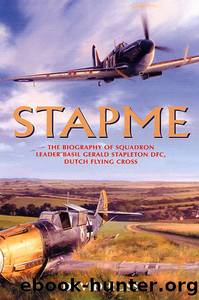Stapme by David Ross

Author:David Ross
Language: eng
Format: epub
Tags: HISTORY / Military / World War II
ISBN: 9781909166691
Publisher: Grub Street Publishing
Published: 2008-09-08T00:00:00+00:00
CHAPTER SEVEN
FLYING COMMAND
On 25 July 1944, Stapme was back on flying duties with No.83 Group Support Unit. He returned to operations on 23 August 1944 with 247 (China-British) Squadron, part of 124 Wing, 2nd Tactical Air Force (TAF), flying Typhoons from beachhead code B.6 in northern France. He:
. . . travelled down to Hurn where, with a number of other Typhoon pilots, I carried out a series of flights to re-acquaint myself, I then did a few more trips during which I fired off my rockets at a target in the sea. From Hurn I flew across to the B.6 landing ground.
On 25 August, 247 Squadronâs Commanding Officer, Squadron Leader Robin McNair, who had recently led them in the operation to close the Falaise Gap, was tour-expired and with a Bar added to his DFC, was posted back to England. Stapme took over the following day. Later described by his fellow squadron members as: â. . . a tall South African with blond hair and a Buffalo Bill moustache,â Stapme was recognised as an âaceâ of the Battle of Britain and although his former nickname was known, he was called by the more traditional nickname for a CO: âThe Bossâ. Also, on 25 August 1944, the Allied forces liberated Paris.
Flight Lieutenant Basil T. âTattersâ Tatham, his B Flight Commander, had also only just been appointed and was on his second tour of duty. Stapme developed great respect for Tatters, during what was a particularly hectic period of fighting, which he maintains to this day. Tatters was destined temporarily to take over command of the Squadron when Stapme was reported âmissingâ. Having attained the position of commanding officer, this period of Stapmeâs career was very eventful and could be considered the pinnacle of his wartime flying career.
Shortly after arriving, he had his choice of a logo painted on the starboard side of the fuel tank cowling of his particular aircraft, MP126, code ZY-Y, by the squadron artist Flying Officer âSpyâ McKay. The brightly coloured artwork showed the Nazi swastika with an eagle atop in flames as the result of a sixty-pound rocket which was just making contact with the middle of the swastika. Stapme named it âExcreta Thermoâ but, prudently, Spy McKay didnât include the wording. Spy also designed the squadron Christmas card for 1944, which, as fate decreed, Stapme would miss. In 2001, Spyâs daughter visited Stapme and together they enjoyed a chat about her late father, his time with 247 Squadron and the legacy of his artwork.
Based on the European mainland, 247 Squadron initially took part in operations to close the Falaise Gap from their airfield at B.6 (Coulombs), where Stapme took over command. As the allied forces advanced inland, so the squadron followed, first to B.48 (Amiens/Glisy), then B.58 (Melsbroek) and, finally, during Stapmeâs time with the Squadron, B.78 (Eindhoven). 247 provided aerial support throughout the Arnhem campaign and for his service during that battle Stapme was awarded the Distinguished Flying Cross (Dutch).
In Normandy the pilots had ample supplies of the locally produced Calvados (apple brandy) which Stapme remembers with amusement: â.
Download
This site does not store any files on its server. We only index and link to content provided by other sites. Please contact the content providers to delete copyright contents if any and email us, we'll remove relevant links or contents immediately.
Kathy Andrews Collection by Kathy Andrews(11677)
The remains of the day by Kazuo Ishiguro(8739)
Paper Towns by Green John(5022)
Spare by Prince Harry The Duke of Sussex(4994)
The Body: A Guide for Occupants by Bill Bryson(4886)
Industrial Automation from Scratch: A hands-on guide to using sensors, actuators, PLCs, HMIs, and SCADA to automate industrial processes by Olushola Akande(4845)
Machine Learning at Scale with H2O by Gregory Keys | David Whiting(3968)
Be in a Treehouse by Pete Nelson(3875)
Harry Potter and the Goblet Of Fire by J.K. Rowling(3737)
Never by Ken Follett(3703)
Goodbye Paradise(3666)
Into Thin Air by Jon Krakauer(3261)
The Remains of the Day by Kazuo Ishiguro(3254)
The Cellar by Natasha Preston(3219)
The Genius of Japanese Carpentry by Azby Brown(3189)
Fairy Tale by Stephen King(3156)
120 Days of Sodom by Marquis de Sade(3117)
Drawing Shortcuts: Developing Quick Drawing Skills Using Today's Technology by Leggitt Jim(2960)
The Man Who Died Twice by Richard Osman(2954)
